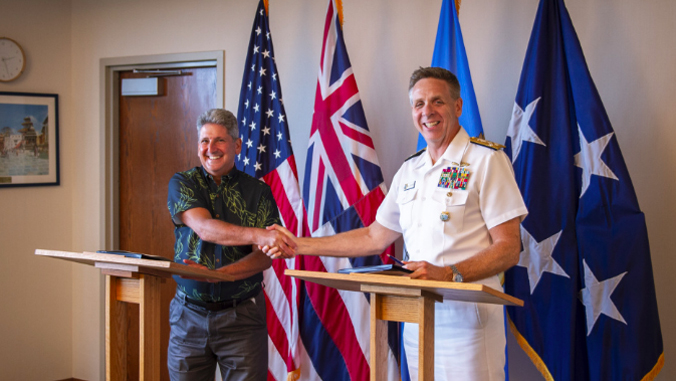
Development of new technologies, climate-change solutions, and student educational and career opportunities are just some of the aims of a new agreement between the University of Hawaiʻi and the U.S. Indo-Pacific Command (INDOPACOM).
INDOPACOM is tasked with using and integrating the four branches of the military within the Indo-Pacific region to achieve U.S. national security objectives while protecting national interests. A memorandum of understanding was signed at an April 20 ceremony setting the foundation for INDOPACOM and UH to collaborate in multiple areas and share ideas, initiatives, expertise and values.
UH is a leader in fulfilling the State of Hawaiʻi’s mission to grow and diversify the economy with research and training skilled workers, which aligns with the values of INDOPACOM. The university’s location in the middle of the Pacific bridges the east and west, creating opportunities for influence across its network of international partners and alumni.
“This MOU institutionalizes the shared commitment of UH and INDOPACOM to advance collaboration in Hawaiʻi and across the Indo-Pacific to promote regional stability, sustainability and resilience through research and education,” said UH President David Lassner. “We are excited about the opportunities for our students and faculty to contribute. And as Admiral Davidson prepares to transition out of his current role, we thank him for all he has done for our region and Hawaiʻi.”
Both institutions will explore potential collaborative efforts in the areas of: community resilience and climate change; technology, experimentation and innovation; and international, intelligence, and futures studies education and workforce development.
“This is an exciting opportunity for INDOPACOM to build on our collaborative relationship with the University of Hawaiʻi,” said U.S. Navy Admiral and INDOPACOM Commander Phil Davidson. “We continue to seek opportunities that leverage the unique strengths of the UH faculty and students to advance the stability, security, and sustainability of the Indo-Pacific.”
Areas of collaboration
Community resilience and climate change include natural resource management, disaster response and resiliency, and climate change adaptation to build resiliency that enables the security and prosperity of communities around the region. Examples include assessing sea level rise and coastal inundation impacts on the community.
The partnership will also pursue areas of innovation and technology development across multiple disciplines (engineering, cyber security, artificial intelligence, energy, water, communications, waste, mobility and food). One example is further developing the Hacking for Defense program to include more subject areas. Currently, UH Mānoa’s College of Engineering is involved in the program, which provides opportunities for students to develop innovations to address existing national security issues presented by the U.S. Department of Defense. Plans are being made to expand the program into a multidisciplinary course in fall 2021 that will include the UH Mānoa Department of Information and Computer Sciences and Shidler College of Business.
- Related UH News story: New UH partnership to aid national security, boost state’s economy, March 17, 2021
The focus on education and workforce development will expand educational opportunities for students while highlighting career pathways in the defense and intelligence communities. One example that resulted from collaborative efforts is an internship course offered in the spring 2021 semester in UH Mānoa’s College of Social Sciences. The course provides students an opportunity to explore possible careers in national security. Fifteen students were selected to participate in the first “INDOPACOM–UHM Mentoring Program for Intelligence.” Regular fall courses are planned, while a larger certificate program is being developed.
- Related UH News story: Students discover careers in intelligence through UH, military partnership, April 5, 2021
This partnership is an example of UH Mānoa’s goal of Enhancing Student Success (PDF), Excellence in Research: Advancing the Research and Creative Work Enterprise (PDF) and Building a Sustainable and Resilient Campus Environment: Within the Global Sustainability and Climate Resilience Movement (PDF), three of four goals identified in the 2015–25 Strategic Plan (PDF), updated in December 2020.

